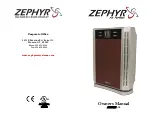
98
RT-SVX24Q-EN
N
No
otte
e:: Lead-Lag is not available with the variable speed
compressor option.
Units Equipped with 100% Modulating
Exhaust
The exhaust dampers are controlled through an
Exhaust/Comparative Enthalpy Module (ECEM). The
ECEM module receives input from a space transducer
and modulates the exhaust dampers to maintain the
space pressure to within the specified setpoint
controlband.
Modulating Hot Gas Reheat Sequence of
Operation
When the relative humidity in the controlled space (as
measured by the sensor assigned to space humidity
sensing) rises above the space humidity setpoint,
compressors and the supply fan will energize to reduce
the humidity in the space.
All compressors on both refrigerant circuits will be
staged up during active hot gas reheat. Circuit #1 is
designated the reheat circuit and will feature additional
refrigerant control devices as well as a split condenser
coil with one section in the indoor air stream and the
other in the outdoor coil compartment.
While hot gas reheat is active, the discharge air will be
controlled to the Supply Air Reheat Setpoint by
modulating the amount of reheat produced by the
reheat coil. The Supply Air Reheat Setpoint, Occupied
and Unoccupied Dehumidification Setpoints are
adjustable via the human interfaceBAS/Network
control, or GBAS.
Hot gas reheat will be terminated when the humidity in
the space is reduced to the active space humidity
setpoint - 5% or when an overriding condition such as
heating or cooling demand or a failure occurs in a
component required for dehumidification.
On VAV units, at start-up, satisfying the VAV Occupied
Cooling setpoint, MWU setpoint, and DWU setpoint
will have priority over dehumidification mode. Once
heating modes are satisfied, and the unit is satisfying
the SA Cooling Setpoint, dehumidification mode will
be entered if no more than half the unit mechanical
cooling capacity is requested.
On SZVAV units, hot gas reheat will be similar to VAV
modulating hot gas reheat with the exception of a
dynamic Supply Air Reheat Setpoint. Rather than
utilizing a static Supply Air Reheat Setpoint, once the
unit enters dehumidification, the Discharge Air
Setpoint will be calculated based on the Zone
temperature vs. Zone Cooling Setpoint error and will
be capped at the user selected Supply Air Reheat
setpoint.
Hot gas reheat is not allowed during VAV Heating
Modes (Changeover input closed). Once active, hot gas
reheat control will remain active for a minimum of
three minutes unless a priority unit shutdown request
is received or the High Pressure Control input opens on
either circuit.
Hot gas reheat control can be enabled separately for
occupied and unoccupied modes of operation via the
Human Interface and is overridden/disabled whether
active or inactive by the following methods:
•
Priority unit shutdown conditions (Emergency stop,
Ventilation Override, Network Stop, etc.)
•
Compressor circuit manual reset lockouts on either
circuit. Low Refrigerant Charge monitoring is active
during dehumidification mode and will lockout
compressor circuits based on the same criteria used
for cooling mode.
•
Outdoor Air Temp is less then 40°F or greater the
100°F.
•
Humidity Sensor Failure
•
For VAV units, (in occupied) hot gas reheat will be
disabled if space temp is less than the Dehumid
Override Low Zone Setpoint or higher than the
Dehumid Override High Zone Setpoint. If hot gas
reheat is inactive it will not be allowed until it space
temp rises higher than the Dehumid Override Low
Zone Se 1.0°F or lower than the Dehumid
Override High Zone Setpoint - 2.0°F.
•
For SZVAV units, hot gas reheat will be disabled if
space humidity levels have fallen below the Active
Occ/Unocc Dehumidification Setpoint -5%
Dehumidification Hysteresis Offset, the zone
temperature has dropped too close to the Zone
Heating Setpoint in any unit mode (Zone Temp. is
less than ZHSP + 0.5°F), the zone temperature rises
above the Zone Cooling Se2°F in any unit
mode, Entering Evaporator Temperature falls too
low, Froststat input becomes active, or Reheat
becomes disabled.
•
For CV and all units in unoccupied, if space temp is
less than the Zone Heating Setpoint (ZHSP) + 0.5° F
if hot gas reheat is active, or less than ZHSP + 1.0° F
if not hot gas reheat mode will be disabled. If zone
conditions result in a cooling request for more than
one-half the available cooling capacity of the unit
hot gas reheat will be disabled and will transition to
cooling control. If hot gas reheat is inactive,
dehumidification will not be allowed until the active
unit cooling capacity request drops to half the
available cooling capacity or less, unless the space
temp is less than the Zone Cooling Setpoint.
•
In CV units in occupied mode, if the unit is not in
“AUTO” system mode and is set to “HEAT” system
mode via the HI, BAS, or Zone Sensor device,
dehumidification control will be disabled at space
temps above Occupied ZCSP + 1.0° F. If
dehumidification is inactive it will not be allowed to
activate if space temp is greater than the OZCSP.
All units configured for modulating hot gas reheat will
have a reheat condenser coil purge function to ensure
proper refrigerant distribution in the reheat circuit. This
feature is always enabled and will monitor the amount
Содержание IntelliPak 2 Series
Страница 217: ...RT SVX24Q EN 217 N No ot te es s...
Страница 218: ...218 RT SVX24Q EN N No ot te es s...
Страница 219: ...RT SVX24Q EN 219 N No ot te es s...
















































